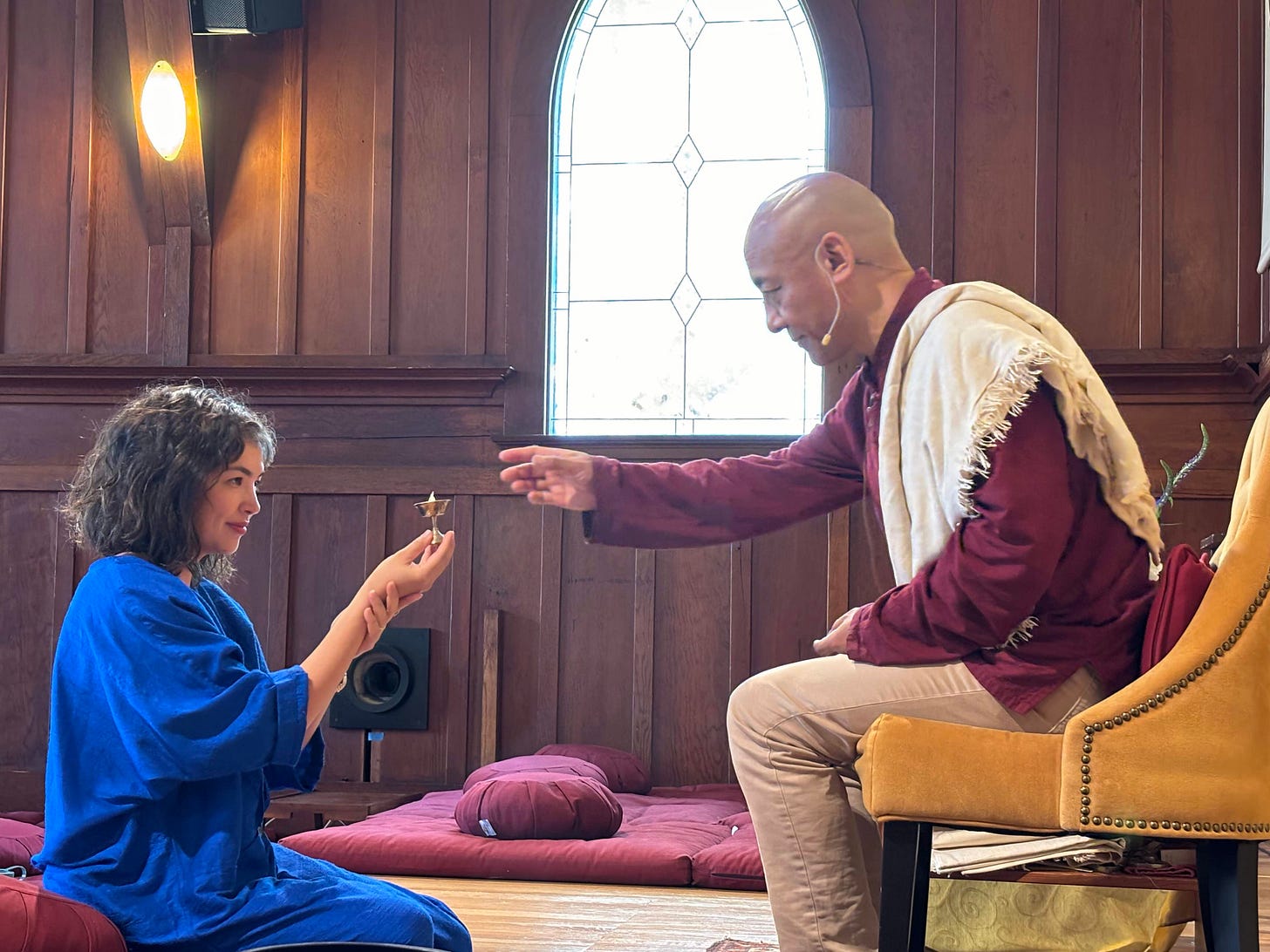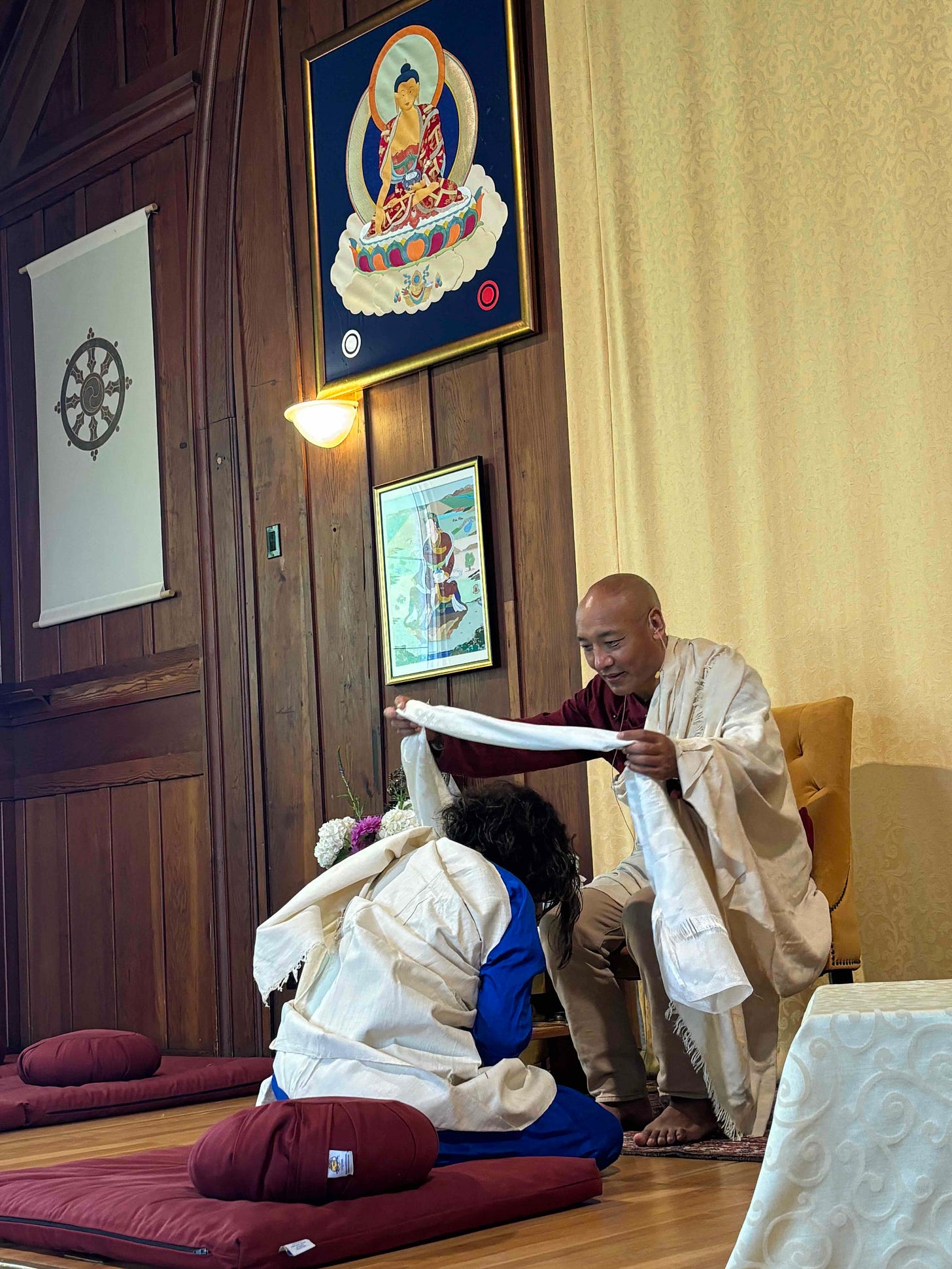Dear dharma friends,
One of the first dharma talks I ever heard from Anam Thubten was about a secret mantra. It was very powerful. He was willing to tell us, he said, because he thought we were ready. Anam Thubten asked if we wanted to hear the mantra. As you can imagine, everyone leaned forward. Here it is, he said: “Ohm Chill Out.” He leaned back and laughed. We all laughed too. This was my first encounter with Rinpoche’s humor. He was building on our ingrained expectations of an exotic teaching from a Tibetan teacher. Humor is an effective mirror. He went on to explain that ohm chill out is actually a good mantra to use. Apparently, I have never forgotten the talk.
As I move through one of the bigger transitions of my life, there’s a phrase that keeps coming to me in meditation. Are you ready to receive a powerful, mystical, esoteric mantra? You can become one of the few initiated into the pith essence of Buddhism. Here it is, in three words: Don’t Get Stuck.
I know. So simple! In some ways I do think the essence of Buddhism is contained in this mantra. When we are stuck, we are reifying, which is to make something concrete, solid, real. You could say we’re taught to reify our whole life. As a young child when you tell your parents a story, you’re reifying. Even if you know somewhere inside that actually you provoked your brother, when you say your brother hit you, you start to believe it. You can even start to feel aggrieved. It’s pretty amazing how quickly an invented narrative concretizes. I’m watching this unfold with my sons right now. The toddler shouts, “Ow! Ow!” with a heart-tugging expression of pain, when really, he wants the toy his older brother is holding.
In school we’re taught to create a narrative and defend it. Debate, English, History are about constructing a convincing argument. Socially, when we tell our friends a story of something that happened, we’re often subtly manipulating it so we look better. Each time we go over the story, the other person can look worse, and we can feel that righteous pride of the victim. We’re reifying.
Joan Didion said, “We tell ourselves stories in order to live.” Lately, I’ve begun to ask if that’s a good thing. Narratives can trap us. We get stuck.
In Buddhist terminology stories are “projections.” I like this word because it throws the story out of our bodies and onto a blank white wall. There’s distance between the self and the story. We can imagine slotting one of those old film reels into the projector. We have the choice to project a horror film or a comedy. Some days our mind scares us; some days it shows us something we want to see. Either way, by projecting we’re living in a fantasy of the past or an idea of the future.
Maybe you, like me, have been watching political speeches of late. We’re being sold two different projections of America. This country is complex. It’s a full orchestra. Both parties are trying to make us choose between, say, horns or violins. They’re making something concrete that is actually always moving, changing. It is not true that all immigrants have the opportunity to succeed here, just as it is not true that people are crossing the border and coming to get us. Fear is a projection. So is anger, and so is hope. The aggressive projections can seem reassuring. They have a solidity that trick us into thinking they are real. That’s why fear, anger, hatred and greed are often used as weapons.
Buddhism talks about change. Life is always changing on us. The ground of our existence is change. As long as we don’t come to peace with that, there is suffering. And change is hard! Ask any parent of young kids. Transitions suck. I’m not sure transitions get easier for adults. We just forget that all of life is transition, and transition is hard.
Not only is life in flux, but we aren’t real. There is no intrinsic me. Seen from the perspective of eons of reincarnated cycles, it isn’t a big deal to loosen our grip on our names, our identities, our bodies, our partners, or our kids. The ego isn’t so happy with Buddhist reality. It says hey, can we turn it down a little? We can be sympathetic. This is hard to hear.
We aren’t real. We don’t have to take our stories seriously. This is the opposite of what we’ve been taught to do all along. Personally, I’ve gotten it completely wrong. I’ve spent my life working to be an A+ student of suffering. I’ve been taking my stories the most seriously. I’ve held them tight.
If you want to see how race is a construct, try being mixed race, as I am. In Asia it is my Whiteness that is visible; in America I’m perceived as an Asian woman, as a woman of color. I morph according to the continent. During the Trump presidency, when he was spewing Asian hate over Covid, Asian elders were being killed. There is probably no greater pain for a culture that venerates elders than to witness our elders being targeted. I had a hard time. There was empathetic pain, fear, anger, and pain myself. I had experiences in public, at work, and socially that I came to interpret through the lens of my identities. I thought people were saying stuff because I'm Asian and female. Sometimes what they said was indeed about these identities. But from the perspective of a few years and some reflection, I also see that I was reifying my identities.
I began to play defense with the world. When I met someone new, I’d try to gauge if they would hurt me. I got tighter, winding myself in a mouse trap of a story about how my identities made me vulnerable, and how people wanted to exploit them. I turned these stories into boulders that I carried around. My stories started to trap me.
This is a common way to move through the uncertainty that characterizes our existence. This is an understandable reaction to being human. The truth is that skin color, gender, class, and race are all bad predictors of our next best friend. Closing our heart is the ego holding onto a primitive story, which is that it alone can protect us. Our dear ego is doing its best. We can thank it for trying. In fact it is doing the exact wrong thing. We end up living almost entirely in our projections, and we aren’t protected at all.
The way to live is so simple that it seems absurd. You take this leap with your heart and your body. You open. You notice what is happening in front of you and how you respond to it. You drop the projections. You live in the present. You don’t need to take anything too seriously. You don’t try to be the A+ student of suffering. You let the stuff of life drop off you, again and again and again.
In the run-up to my ordination I was living in some swell projections. Maybe when I took my vows I would be in a field of bliss. Maybe I’d get a new name. Maybe I’d get a title— that would be nice. A little credibility would help. At least, I was sure that by the time of my ceremony I would have an idea of what I’m doing as a dharma teacher.
We can laugh and bow to the diligent work of my ego. My teacher goes by Anam Thubten, which is his name. Of course I wasn’t going to get a new name, or a title. Anam Thubten did say that in Tibet I would get a hat at the ceremony, but America is hard— no hats!
Actually, one of the things I experienced at my ordination ceremony was disappointment. I was under-slept and trying to focus on my teacher and not my kids making noise in the temple. I was overwhelmed to be receiving the honor. I still have little idea of what I’m doing here.
Let’s be real. I was moved by Rinpoche’s faith in me; moved to be back in Dhumatala Temple; moved to be witnessed by my friends and my sangha of origin. But there was also grief. Going forward, I will not be at Dhumatala every other Sunday for Rinpoche to feed me an excellent little portion of dharma. I used to be able to go home, do practice, and think: Yeah! A+ dharma student!
That sangha is not my sangha anymore. What we’re building here at Heart Sangha is my new home. I am asked, in the honor of my life, to digest the dharma and offer it to others. Just now I feel like a baby bird pushed out of its nest, plummeting, thinking— fly! Fly! You know how to fly! I am still so very human, in the same old mucky muck.
I know you all know this, so I am reminding us, or else talking to myself: when we drop the projections, the present moment can be incredibly beautiful. Life does that sometimes.
After the ceremony we had lunch in the temple garden. Our toddler ran back and forth delivering food to Rinpoche, who handed the baby packets of Sriracha. The bigger kids made pens from bamboo rods and used redwood acorns as ink. Rinpoche tested each pen before the kids took them back and made corrections.
Life is incredible, humbling, and all of it a sacred dance. To think we can control it is delusion. That creates suffering. My profound, mystical, highly esoteric mantra for you from the other side of ordination is this: Don’t Get Stuck.
May we all find freedom.
Thank you!
Sunisa







Sunisa, Thank you for this and every word you have shared here. I came across your latest yesterday and today like an excited student went back to the start wanting to cherish every thought and every word. So much gratitude. Your offerings here have already had a huge impact on me and I think will continue to bloom in my life. -mina
Sunisa- This is one of the most accurate insight I’ve encountered this year: “Socially, when we tell our friends a story of something that happened, we’re often subtly manipulating it so we look better.” I appreciate it.